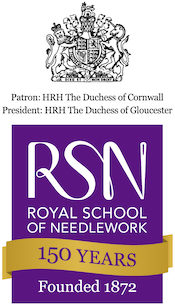International Summer School 2023
Onsite & Online: Bringing the World Together
Exploring Drawing & Sources of Creative Inspiration

- Tutor: Caroline Homfray
- Level: Beginner/Mixed Ability
- Technique: Drawing
- Onsite at Hampton Court Palace Sunday 30 July – Friday 4 August 2023 (excluding Wednesday 2 August), 10am – 4pm
This five-day intensive drawing and design course will introduce you to the most fundamental skills of drawing and seeing as an artist, exploring traditional principles and experimenting in a playful way. If you have never considered yourself a drawer but want to learn how it supports making your own designs, or you want to refresh rusty skills this course is for you.
You’ll gain the tools to see, understand and draw from a wide variety of subject matter, both in the classroom, around Hampton Court Palace and at another venue in London, to be confirmed. We’ll explore as a group how different aspect of drawing can support your embroidery interests, and grow your confidence to move towards producing designs of your own. There will be lots of positive encouragement and support from Caroline, Sonia, and the
class will be run in a mutually supportive way.
Sunday and Monday. Days 1 & 2: Drawing Basics
You will be introduced to basic media and materials. We’ll explore some fundamental techniques and have a play with the materials. You’ll then practise applying that to drawing what you see, with support. You’ll learn:
• How to use graphite drawing pencils to explore and practise mark-making and basic shapes.
• How to check proportions are right.
• How to see and work with negative shapes – the spaces between things.
• How to scale things up and down.
• Simple perspective and how that relates to what you see.
On the second day we’ll concentrate on developing your drawing with tone: how light or dark something is -essential for making your drawings look three-dimensional, and for helping designs to ‘read’ clearly. We will explore:
• Graphite, pen, and charcoal, to explore how to create a wide range of tones, and how to apply them.
• How to use toned paper as a starting point.
• Using white media to explore the reverse.
• How tone works in images as part of composition or design.
How does all this apply to your embroidery? We’ll discuss that as we work through the different methods.
We’ll practise these skills with lots of observational drawing, both in the classroom and around the palace.
Tuesday. Day 3: Inspiration Gathering.
We’ll spend the day at another venue in London, looking at the collections. There’ll be time to explore and make drawings, with the supportive presence of Caroline and our assistant Sonia, or by yourself or in groups. We’ll discuss:
• What media and equipment to use on a trip like this
• How to manage with drawing and photographing around a collection in the presence of other visitors.
• There will be demonstrations and discussions about what and how to gather images and information
• We’ll look at different objects and how to reduce a lot of information to what matters.
How do you make use of these for future designs? We’ll use some of the materials gathered for Day 5.
Wednesday: Rest day
Thursday, Day 4. Exploring Colour.
This day will help you see more colours, mix them, combine them and
learn how to blend coloured pencils and create your own colour wheel with tints and shades.
• Learn the basic language of colour and some ways of choosing colour schemes, as well
as considering your instinctive response.
• Study some real objects closely, learning to see the subtlety of colours they present,
and learn how to mix them.
• Consider what effect background colours have in an image
• Explore the effect of colour relationships.
Friday, Day 5. Pulling it all Together: Creating Designs.
This is the day which brings it all together: working from research materials you have gathered and observed photographed or collected over the preceding days, you will explore how to use it to create a design. We will play with some processes to generate ideas and ways of putting things together, and consider the difference between design-led and technique-led
approaches.
On this day you will:
• Learn some principles of composition and design: divine proportion, lines of action,
scale, repetition and harmony. Practise these in some drawing and paper cutting exercises.
• Understand how to select and bring together mark making, tone and colour.
• Consider how these operate within textiles: what properties do thread, fabric and stitch have?
• Go through the design process to create a sample design from a brief provided by the tutor.
Outcome
By the end of the course you will have a sketchbook stuffed with drawings, a resource for the future with ideas and inspiration. You will have an understanding of fundamental art principles and ways to use them and play with them. You will also have more confidence in
your own ideas and the enthusiasm to carry on exploring and developing your own style.



